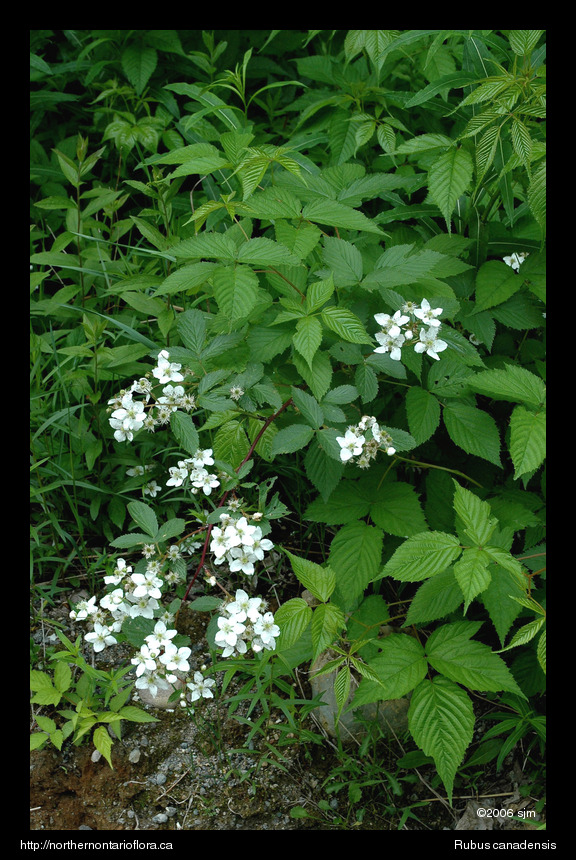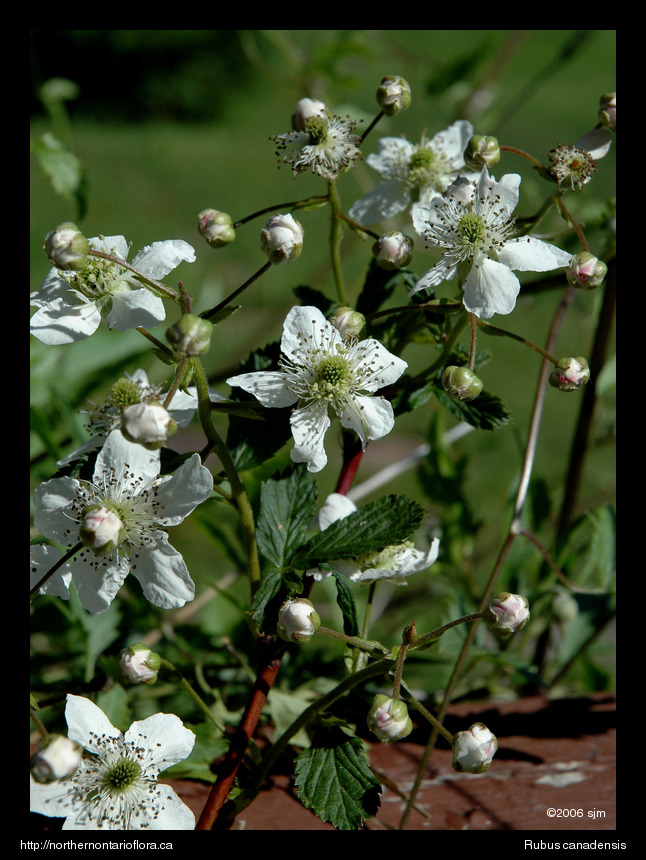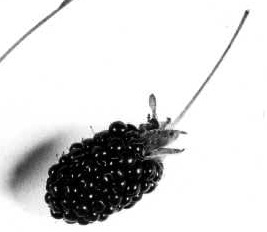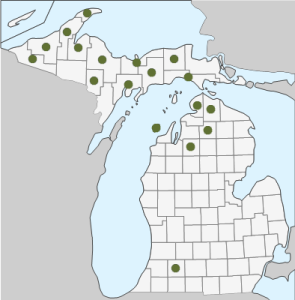 Download PDF
Download PDF
Name: Rubus canadensis L.
Family: Rosaceae, the rose family (1)
 Common Names: Smooth blackberry, Millspaugh’s blackberry, thornless blackberry, smooth bramble, American dewberry, low blackberry, and mountain blackberry (2,6,10,11,14,15).
Common Names: Smooth blackberry, Millspaugh’s blackberry, thornless blackberry, smooth bramble, American dewberry, low blackberry, and mountain blackberry (2,6,10,11,14,15).
Etymology: Rubus is Latin for blackberry or raspberry, and canadensis means “from Canada” (5).
Botanical synonyms:
Rubus argutus var. randii (L.H. Bailey) L.H. Bailey
Rubus besseyi L.H. Bailey
Rubus forestalis L.H. Bailey
Rubus illustris L.H. Bailey
Rubus irregularis L.H. Bailey
Rubus laetabilis L.H. Bailey
Rubus millspaughii L.H. Bailey
Rubus randii (L.H. Bailey) Rydb. (2)
Quick Notable Features (1):
¬ Stems without thorns or prickles
¬ Palmately compound leaves, typically with 5 leaflets, glabrous
¬ Terminal leaflet with semi-cordate base and long petiolule, 2 basal leaflets nearly sessile
¬ Many white flowers in a raceme each giving way to aggregates of black drupelets
Plant Height: R. canadensis grows from 1.5-3m tall (6).
Subspecies/varieties recognized (2,8,10):
Rubus canadensis var. imus L.H. Bailey
Rubus canadensis var. elegantulus (Blanch.) Farw.
Rubus canadensis var. pergratus (Blanch.) L.H. Bailey
Rubus canadensis var. canadensis
Rubus canadensis var. invisus L.H. Bailey
Rubus canadensis var. millspaughii (Britton) Blanch.
Rubus canadensis var. randii (L.H. Bailey) L.H. Bailey
Rubus canadensis var. roribaccus L.H. Bailey
Rubus canadensis var. septemfoliolatus Blanch.
Rubus canadensis var. terrae-novae (Fernald) L.H. Bailey.
Most Likely Confused with: Among climbing plants, the species is similar to Rubus allegheniensis, R. argutus, R. idaeus, and Rosa setigera. It also resembles the non-climbing species Rhus canadensis (7,8,9,13).
Habitat Preference: It grows in open woodlands, thickets, mountain ridges, recently disturbed sites and roadsides in cool and moist climates (1,6,8,12).
Geographic Distribution in Michigan: R. canadensis is found in 18 counties, with the majority of its distribution spread throughout the Upper Peninsula and northern Lower Peninsula. In southern Michigan, it can be found only in Kalamazoo County (17).
Known Elevational Distribution: R. canadensis grows at high elevations, up to 1980 meters above sea level in the Smoky Mountains (12).
Complete Geographic Distribution: Native to North America. R. canadensis can be found in the United States (CT, GA, KY, MA, MD, ME, MI, MN, NC, NH, NJ, NY, OH, PA, SC, TN, VA, VT, WI, WV), Canada (NB, NF, NS, ON, PE, QC), and France (SPM) (2).
 Vegetative Plant Description: The stems are smooth (prickles rare) and can be erect or arching, glabrous or glabrescent. Leaves are alternate, palmately compound, with long smooth petioles, and usually bearing 5 leaflets (sometimes 3). The leaflets of the primocanes are larger than the leaflets of the floricanes, with the terminal leaflet measuring 10-20cm long, 4-5.5cm wide and petiolule 4-10cm long. The petiolules of the median leaflets are shorter, while the petiolules of the lower leaflets are nearly absent, measuring no more than 5mm. The leaflets are usually glabrous on both sides, narrow to broadly ovate, acuminate, serrate, with the non-terminal leaflets measuring up to 15cm long and 5cm broad. (6,7,9,13).
Vegetative Plant Description: The stems are smooth (prickles rare) and can be erect or arching, glabrous or glabrescent. Leaves are alternate, palmately compound, with long smooth petioles, and usually bearing 5 leaflets (sometimes 3). The leaflets of the primocanes are larger than the leaflets of the floricanes, with the terminal leaflet measuring 10-20cm long, 4-5.5cm wide and petiolule 4-10cm long. The petiolules of the median leaflets are shorter, while the petiolules of the lower leaflets are nearly absent, measuring no more than 5mm. The leaflets are usually glabrous on both sides, narrow to broadly ovate, acuminate, serrate, with the non-terminal leaflets measuring up to 15cm long and 5cm broad. (6,7,9,13).
Climbing Mechanism: Trailing (14), with no specialized mechanism for ascension.
Flower Description: The inflorescences are composed of many perfect, actinomorphic flowers (2.5-4cm across) in long racemes. Each flower is subtended by stipule-like bracts (1-2cm long). Pedicels (2-4cm long) are slightly pubescent and glandless. R. canadensis flowers have five sepals (up to 0.7cm long) with a woolly pubescence on the inner side, five white petals (1.2-2cm long and 0.6-1.2cm wide), many stamens, and compound pistils with superior ovaries and separate styles (1,6,9,13).
Flowering Time: June to August (6).
Pollinator: R. canadensis is a pseudogamous apomict (the species receives pollen, but only the endosperm is fertilized and the seed produced does not contain male inheritance) and usually self fertilizes. However, the flowers produce nectar that is attractive to many species of insect. Bees, beetles, butterflies are known pollinators of other members of the genus Rubus (11,16,18).
 Fruit Type and Description: The aggregate of black drupelets (1.5-2.5cm long) is edible and remains attached to the receptacle when it matures in late July to early September. Each drupelet contains a single seed (1,9,15).
Fruit Type and Description: The aggregate of black drupelets (1.5-2.5cm long) is edible and remains attached to the receptacle when it matures in late July to early September. Each drupelet contains a single seed (1,9,15).
Seed Description: The seeds of R. canadensis require cold stratification for 3 months. There are about 98 seeds per gram. Each seed measures approximately 2.2×1.4mm (12,15).
Dispersal Syndrome: The fruits of R. canadensis are eaten and dispersed by birds and small mammals, but the main dispersal mechanism is vegetative reproduction via rhizomes, root collar sprouting, and layering (12,15).
Distinguished by: R. canadensis can be differentiated from Rubus allegheniensis, R. argutus, and Rosa setigera by its mostly smooth stem and petioles. R. allegheniensis, R. argutus, and Rosa setigera have predominantly pubescent to glabrescent stems and petioles with prickles. R. allegheniensis can also have from three to seven leaflets, while R. canadensis only has three to five, and although the leaflet shape is very similar on both species, R. allegheniensis will have hairs on both surfaces. R. argutus has smaller leaflets (3-12cm long and 1-6cm wide) that are densely pubescent on the under surface, possibly finely pubescent on the upper surface, and less acuminate than R. canadensis. In addition, the inflorescence of R. argutus is borne in cymes, not racemes. The stems of R. idaeus are glandular and bristly; its leaflets (3-5) can be slightly lobed, with the underside glaucous and pubescent. The leaflets are also smaller (up to 11cm long) than those of R. canadensis. The fruits of R. idaeus are red aggregates that separate from the receptacle when mature, while R. canadensis fruits stay attached to the receptacle and are black. Rhus canadensis has trifoliate, aromatic leaves (up to 12cm long) that are pubescent to glabrescent on both sides; the teeth are large and irregular, with an acute to rounded apex. The spreading branches of Rhus canadensis grow to about the same height as Rubus canadensis. The flowers of Rhus canadensis are yellow and the fruit is a single red, pubescent drupe. Rosa setigera stems are mostly climbing with glandular pubescent twigs, petioles, and pedicels. The leaves have three to five leaflets (usually 3) measuring up to 7cm long with an acute to obtuse apex and may have soft pubescent on the underside. The flowers of Rosa setigera are borne in corymbs, they are pink and larger (6cm across) than those of R. canadensis, and the fruit is derived from the receptacle and matures as a single red rose hip (6,9).
Other members of the family in Michigan: Agrimonia (5), Amelanchier (6), Aronia (1), Aruncus (1), Chaenomeles (1), Chamaerhodos (1), Comarum (1), Cotoneaster (2), Crataegus (29), Dalibarda (1), Dasiphora (1), Drymocallis (1), Filipendula (3), Fragaria (2), Geum (10), Kerria (1), Malus (6), Physocarpus (1), Potentilla (15), Poterium (1), Prunus (17), Pyrus (3), Rhodotypos (1), Rosa (16), Rubus (15), Sanguisorba (1), Sibbaldiopsis (1), Sorbaria (1), Sorbus (3), Spiraea (5) (source 17).
Ethnobotanical Uses: The fruit is one of the most cherished wild blackberries and can be eaten fresh, dried, or made into preserves. The fruit can be made into a purplish dye. The stems, roots, and fruits can be used to treat dysentery. R. canadensis is an excellent colonizer and is able to grow on low nutrient soil, making it a species used to control erosion and recover eroded terrain (11,12).
 Phylogenetic Information: The genus Rubus is classified as a member of the subfamily Rosoideae in the family Rosaceae, which is in the order Rosales, a Eudicot clade of the angiosperms. Members of the Rosaceae family can be found worldwide, and the genus Rubus is found in both north and south temperate climatic zones (3,4).
Phylogenetic Information: The genus Rubus is classified as a member of the subfamily Rosoideae in the family Rosaceae, which is in the order Rosales, a Eudicot clade of the angiosperms. Members of the Rosaceae family can be found worldwide, and the genus Rubus is found in both north and south temperate climatic zones (3,4).
Interesting Quotation or Other Interesting Factoid not inserted above: R. canadensis is endangered in Kentucky and New Jersey (2). The distribution map of R. canadensis in 1949 indicates that the plant formerly was more common in the southern portion of the Lower Peninsula (MI). Its range has shifted northward, at least in Michigan (2,6). The vegetative parts of R. canadensis are an important food source for deer and rabbits (12).
Literature and websites used:
- Fernald, M.L. 1950. Gray’s Manual of Botany, 8th ed. New York: American Book Co.
- The PLANTS Database: USDA, NRCS, 1991-2007. http://plants.usda.gov/java/profile?symbol=RUCA
- Judd, W.S., C.S. Campbell, E.A. Kellogg & P.F. Stevens. 1999. Plant Systematics: A Phylogenetic Approach. Sunderland, Massachusetts: Sinauer Associates, Inc.
- Stevens, P.F. Angiosperm Phylogeny Website. Version 9 June 2008. http://www.mobot.org/mobot/research/apweb.
- Brown, R.W. 1956. Composition of Scientific Words. Washington, D.C.: Smithsonian Institution Press.
- Billington, C. 1949. Shrubs of Michigan. Bloomfield Hills, Michigan: Cranbrook Institute of Science.
- Gleason, H.A. 1963. Illustrated Flora of the Northeastern United States and Adjacent Canada, Volume 2. New York, New York: Hafner Publishing Company, Inc.
- Voss, E.G. 1985. Michigan Flora Part II: Dicots. Ann Arbor, Michigan: Cranbrook Institute of Science.
- Radford, A.E., H.E. Ahles, & C.R. Bell. 1968. Manual of the Vascular Flora of the Carolinas. Chapel Hill, North Carolina: The University of North Carolina Press.
- Tropicos.org. Missouri Botanical Garden. 12 Jul 2011 http://www.tropicos.org/Name/27801823
- Plants For A Future, 1996-2010. Rubus canadensis. http://www.pfaf.org/user/Plant.aspx?LatinName=Rubus%20canadensis
- Coladonato, M. 1994. Rubus canadensis. In: Fire Effects Information System, [Online]. U.S.D.A., Forest Service, Rocky Mountain Research Station, Fire Sciences Laboratory. http://www.fs.fed.us/database/feis/ [2011, July 13].
- Meades, S.J., D. Schnare, K. Lawrence, & C. Faulkner 2004-2011. Northern Ontario Plant Database Website. Version 1, January 2004. Algoma University College and Great Lakes Forestry Centre, Sault Ste. Marie, Ontario, Canada. http://www.northernontarioflora.ca/description.cfm?speciesid=1005055
- Parkhurst, H.E. 1903. Trees, shrubs and vines of the northeastern United States. New York, New York: C. Scribner’s Sons.
- Schopmeyer, C.S. 1948. Seeds of Woody Plants in the United States. Forest Service U.S.D.A. Agriculture Handbook No. 450. Washington, DC.
- Craig, D.L. 1960. Studies on the cytology and the breeding behaviour of Rubus canadensis L. Canadian Journal of Genetics and Cytology 2: 96-102.
- Michigan Flora Online. A.A. Reznicek, E.G. Voss, & B.S. Walters. February 2011. University of Michigan. Web. 11-8-2011. http://michiganflora.net/home.aspx.
- Zomleffer, W.B. 1994. Guide to Flowering Plant Families. Chapel Hill, North Carolina: The University of North Carolina Press.
Image Credits (all used with permission):
1, 2) Image of habit and flower courtesy of Susan J. Meades @ northernontarioflora.ca, herbaria@NRCan.gc.ca http://www.northernontarioflora.ca/description.cfm?speciesid=1005055, see citation 13
3) Image of fruit courtesy of USDA-NRCS PLANTS Database (ok to use) http://plants.usda.gov/java/largeImage?imageID=ruca16_003_ahp.tif
4) Species distribution map, derived from the Michigan Flora Online.
Primary Authors: Cristine V. Santanna, with editing by Jenna Dorey, John Bradtke, and Robyn J. Burnham.
© Robyn J. Burnham, University of Michigan
For additional information on Michigan Plant Diversity web pages please contact Robyn J. Burnham via email: rburnham“at”umich.edu